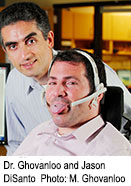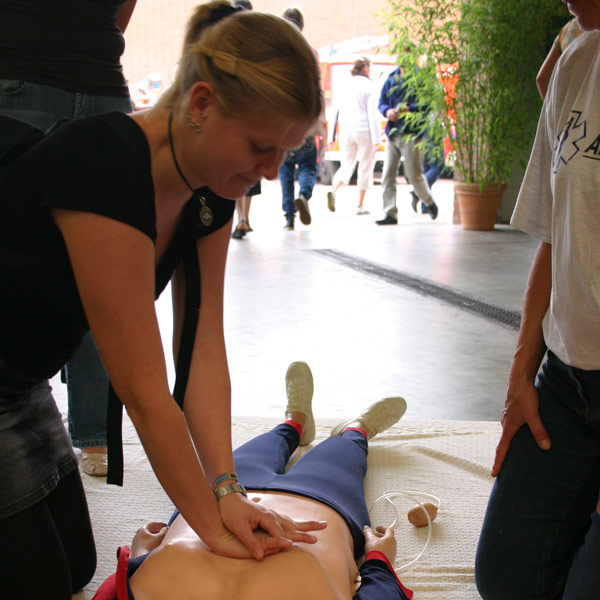
WEDNESDAY, Nov. 27, 2013 (HealthDay News) — Tongue piercings may be stylish in some circles, but they also are central to the latest innovation in wheelchair mobility for folks paralyzed from the neck down.
Researchers have developed a new navigation system for powered wheelchairs in which patients use a magnetic tongue piercing to steer their chair about, according to new research published Nov. 27 in Science Translational Medicine.
The “Tongue Drive System” uses sensors located near a person’s cheeks to track the movement of the magnetic tongue piercing. Signals from the sensors are picked up by a smartphone, which then relays them to the powered wheelchair.
Essentially, the patient’s tongue becomes the joystick through which they steer their wheelchair.
“There is absolutely no difference between the tongue piercing you need for this device and the one you get at your local tattoo parlor,” said study co-author Maysam Ghovanloo, an associate professor in the School of Electrical and Computer Engineering at the Georgia Institute of Technology. “The only difference is we’ve replaced the jewelry with a small magnet.”
In clinical trials, paralyzed people were able to use the Tongue Drive to steer their wheelchairs much more quickly and just as accurately as those using the most popular current technology, in which a person steers by sipping or puffing into a straw.
On average, 11 quadriplegics testing the Tongue Drive steered their chairs three times faster than they did when they used the sip-and-puff system, even though more than half had been using sip-and-puff every day for years, researchers reported.
“It actually does quite well,” said Jason DiSanto, 39, a quadriplegic electrical engineer who participated in the clinical trial. “The big advantage is it’s more intuitive. I felt when I was learning to drive with the sip and puff, learning the different commands was cumbersome in the beginning. With the tongue drive system, that guesswork wasn’t there anymore.”
For example, roll your tongue to the left or right and the wheelchair turns in that direction, as opposed to taking a soft sip for a left turn or a soft puff for a right turn, he said.
The device could replace the sip-and-puff devices now being used by 10,000 to 15,000 quadriplegics in the United States, said Paul Tobin, president and CEO of the United Spinal Association, an advocacy group for people with spinal cord injuries.
“I think it’s an incredible opportunity to provide a higher level of independence,” Tobin said. “The device is much more versatile and sensitive, so it provides much greater levels of accuracy for driving a power chair.”
It also could prove helpful to the one in 50 Americans who are afflicted with paralysis in their upper or lower extremities due to a wide variety of reasons, study co-author Ghovanloo said. Causes include stroke, multiple sclerosis, cerebral palsy, polio and traumatic brain injury.
“As long as the patient can move his or her tongue reliably and consistently, they should be able to use this technology,” Ghovanloo said. “The tongue is directly connected to the brain, so even people with severe spinal cord injuries are able to move their tongues.”
The Tongue Drive is probably a couple of years away from receiving U.S. Food and Drug Administration approval and going out onto the market, Ghovanloo said. When it does, the navigation system likely will cost between $6,000 and $7,000.
The drive now in clinical testing uses cheek sensors attached to a headset placed on the outside of the person’s head. However, researchers already are working on the next-generation model — one that will fit the sensors inside the mouth.
“We have shrunk the technology so the whole thing fits inside the mouth,” Ghovanloo said. “It’s completely hidden from sight, and because it’s inside the mouth, it’s much better protected in the outdoor environment.”
Researchers also believe that the tongue drive could be used to operate a computer or any wireless device, since the tongue motions mapped by the drive could be adapted to command any piece of hardware.
The best part may be that the piercing never needs to be replaced. “It never runs out of juice because it is a passive device,” Ghovanloo said. “It’s just a simple magnet.”
But in the end, a person does have to get a tongue piercing, which can be painful and troublesome.
“That was a new experience, but it went quite well,” DiSanto said of his piercing. “The recovery time went quite well. A couple of weeks of swelling and a little slurred speech.”
More information
For more about spinal cord injuries, visit the U.S. National Library of Medicine.
Copyright © 2025 HealthDay. All rights reserved.

